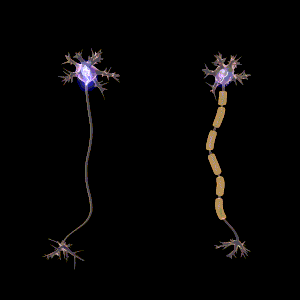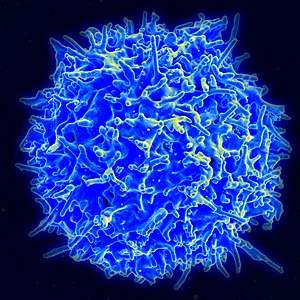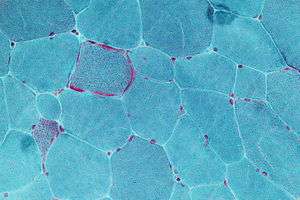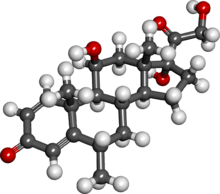Polyneuropathy
Polyneuropathy (poly- + neuro- + -pathy) is damage or disease affecting peripheral nerves (peripheral neuropathy) in roughly the same areas on both sides of the body, featuring weakness, numbness, and burning pain.[3] It usually begins in the hands and feet and may progress to the arms and legs and sometimes to other parts of the body where it may affect the autonomic nervous system. It may be acute or chronic. A number of different disorders may cause polyneuropathy, including diabetes and some types of Guillain–Barré syndrome.[4][5][6]
| Polyneuropathy | |
|---|---|
 | |
| Micrograph showing peripheral neuropathy (vasculitis).Polyneuropathy is peripheral neuropathy occurring in the same area on both sides of the body. | |
| Specialty | Neurology |
| Causes | Hereditary (Charcot–Marie–Tooth disease), and Acquired (alcohol abuse)[1] |
| Diagnostic method | Nerve conduction study, urinalysis[2][3] |
| Treatment | Occupational therapy, weight decrease (management)[3] |
Classification
Polyneuropathies may be classified in different ways, such as by cause,[1] by presentation,[3] or by classes of polyneuropathy, in terms of which part of the nerve cell is affected mainly: the axon, the myelin sheath, or the cell body.[7][8]

- Distal axonopathy, is the result of interrupted function of the peripheral nerves.[9] It is the most common response of neurons to metabolic or toxic disturbances, and may be caused by metabolic diseases such as diabetes, kidney failure, connective tissue disease, deficiency syndromes such as malnutrition and alcoholism, or the effects of toxins or drugs such as chemotherapy. They may be divided according to the type of axon affected (large-fiber, small-fiber, or both), the most distal portions of axons are usually the first to degenerate, and axonal atrophy advances slowly toward the nerve's cell body, however if the cause is removed, regeneration is possible, although the prognosis depends on the duration and severity of the stimulus. People with distal axonopathies usually present with sensorimotor disturbances such as amyotrophic lateral sclerosis[10]
- Myelinopathy, is due to a loss of myelin or of the Schwann cells.[11] This demyelination slows down or completely blocks the conduction of action potentials through the axon of the nerve cell(neurapraxia).[12] The most common cause is acute inflammatory demyelinating polyneuropathy AIDP, the most common form of Guillain–Barré syndrome[13](although other causes include chronic inflammatory demyelinating polyneuropathy )[14]
- Neuronopathy is the result of issues in the peripheral nervous system (PNS) neurons. They may be caused by motor neurone diseases, sensory neuronopathies, toxins, or autonomic dysfunction. Neurotoxins such as chemotherapy agents may cause neuronopathies.[15]
Signs and symptoms
Among the signs/symptoms of polyneuropathy, which can be divided (into sensory and hereditary) and are consistent with the following:[3]
- Sensory polyneuropathy – ataxia, numbness, muscle wasting and paraesthesiae.
- Hereditary polyneuropathy – scoliosis and hammer toes
Causes
The causes of polyneuropathy can be divided into hereditary and acquired and are therefore as follows:[1]
- Inherited -are hereditary motor neuropathies, Charcot–Marie–Tooth disease, and hereditary neuropathy with liability to pressure palsy
- Acquired -are diabetes mellitus, vascular neuropathy, alcohol abuse, and vitamin B12 deficiency
Pathophysiology

In regards to the pathophysiology of polyneuropathy, of course, the former depends on which polyneuropathy. For instance in the case of chronic inflammatory demyelinating polyneuropathy, one finds that it is a autoimmune disease. Here, T cells involvement has been demonstrated, while in terms of demyelination, antibodies alone are not capable.[16]
Diagnosis

The diagnosis of polyneuropathies begins with a history and physical examination to ascertain the pattern of the disease process (such as-arms, legs, distal, proximal) if they fluctuate, and what deficits and pain are involved. If pain is a factor, determining where and how long the pain has been present is important, one also needs to know what disorders are present within the family and what diseases the person may have. Although diseases often are suggested by the physical examination and history alone, tests that may be employed include: electrodiagnostic testing, serum protein electrophoresis, nerve conduction studies, urinalysis, serum creatine kinase (CK) and antibody testing (nerve biopsy is sometimes done).[3][2]
Other tests may be used, especially tests for specific disorders associated with polyneuropathies, quality measures have been developed to diagnose patients with distal symmetrical polyneuropathy (DSP).[17]
Differential diagnosis
In terms of the differential diagnosis for polyneuropathy one must look at the following:
Treatment

In the treatment of polyneuropathies one must ascertain and manage the cause, among management activities are: weight decrease, use of a walking aid, and occupational therapist assistance. Additionally BP control in those with diabetes is helpful, while intravenous immunoglobulin is used for multifocal motor neuropathy.[3]
According to Lopate, et al., methylprednisolone is a viable treatment for chronic inflammatory demyelinative polyneuropathy (which can also be treated with intravenous immunoglobulin). The authors also indicate that prednisone has greater adverse effects in such treatment, as opposed to intermittent (high-doses) of the aforementioned medication.[3][21]
According to Wu, et al., in critical illness polyneuropathy supportive and preventive therapy are important for the affected individual, as well as, avoiding (or limiting) corticosteroids.[22]
See also
References
- MD, Dr Sara J. Cuccurullo (2014-11-25). Physical Medicine and Rehabilitation Board Review, Third Edition. Demos Medical Publishing. p. 434. ISBN 9781617052019. Retrieved 26 August 2016.
- >Burns, Ted M.; Mauermann, Michelle L. (15 February 2011). "The Evaluation of Polyneuropathies". Neurology. 76 (7 Supplement 2): S6–S13. doi:10.1212/WNL.0b013e31820c3622. ISSN 0028-3878. PMC 5766173. PMID 21321354.
- "Polyneuropathies. Medical information about polyneuropathy | Patient". Patient. Retrieved 2016-07-17.
- Richard A C Hughes (23 February 2002). "Clinical review: Peripheral neuropathy". British Medical Journal. 324 (7335): 466–469. doi:10.1136/bmj.324.7335.466. PMC 1122393. PMID 11859051.
- Janet M. Torpy; Jennifer L. Kincaid; Richard M. Glass (21 April 2010). "Patient page: Peripheral neuropathy". Journal of the American Medical Association. 303 (15): 1556. doi:10.1001/jama.303.15.1556. PMID 20407067.
- "Peripheral neuropathy fact sheet". National Institute of Neurological Disorders and Stroke. 19 September 2012.
- Rakel, David; Rakel, Robert E. (2015-02-02). Textbook of Family Medicine. Elsevier Health Sciences. p. 1026. ISBN 9780323313087. Retrieved 26 August 2016.
- McCance, Kathryn L.; Huether, Sue E. (2014-01-30). Pathophysiology: The Biologic Basis for Disease in Adults and Children. Elsevier Health Sciences. p. 635. ISBN 9780323316071. Retrieved 26 August 2016.
- Perry, edited by Michael C. (2007). The chemotherapy source book (4th ed.). Philadelphia, Pa.: Lippincott Williams & Wilkins. p. 241. ISBN 9780781773287. Retrieved 26 August 2016.CS1 maint: extra text: authors list (link)
- Moloney, Elizabeth B.; de Winter, Fred; Verhaagen, Joost (14 August 2014). "ALS as a distal axonopathy: molecular mechanisms affecting neuromuscular junction stability in the presymptomatic stages of the disease". Frontiers in Neuroscience. 8: 252. doi:10.3389/fnins.2014.00252. PMC 4132373. PMID 25177267.
- Hankey, Graeme J.; Wardlaw, Joanna M. (2008). Clinical neurology. London: Manson. p. 580. ISBN 9781840765182. Retrieved 26 August 2016.
- Goodman, Catherine C.; Fuller, Kenda S. (2013-08-07). Pathology: Implications for the Physical Therapist. Elsevier Health Sciences. p. 1597. ISBN 9780323266468. Retrieved 26 August 2016.
- RESERVED, INSERM US14 – ALL RIGHTS. "Orphanet: Acute inflammatory demyelinating polyradiculoneuropathy". www.orpha.net. Retrieved 2016-08-26.
- "Chronic Inflammatory Demyelinating Polyneuropathy (CIDP) Information Page: National Institute of Neurological Disorders and Stroke (NINDS)". www.ninds.nih.gov. Retrieved 2016-07-30.
- Barohn, Richard J.; Amato, Anthony A. (May 2013). "Pattern-Recognition Approach to Neuropathy and Neuronopathy". Neurologic Clinics. 31 (2): 343–361. doi:10.1016/j.ncl.2013.02.001. ISSN 0733-8619. PMC 3922643. PMID 23642713.
- Mahdi-Rogers, Mohamed; Rajabally, Yusuf A (1 January 2010). "Overview of the pathogenesis and treatment of chronic inflammatory demyelinating polyneuropathy with intravenous immunoglobulins". Biologics: Targets and Therapy. 4: 45–49. ISSN 1177-5475. PMC 2846143. PMID 20376173.
- England, John D.; Franklin, Gary; Gjorvad, Gina; Swain-Eng, Rebecca; Brannagan, Thomas H.; David, William S.; Dubinsky, Richard M.; Smith, Benn E. (13 May 2014). "Quality improvement in neurology". Neurology. 82 (19): 1745–1748. doi:10.1212/WNL.0000000000000397. ISSN 0028-3878. PMC 4032209. PMID 24696504.
- "Polyneuropathy/differential diagnosis". BMJ.com. BMJ Best Practices. Retrieved 26 August 2016.
- Chronic renal failure, Medline Plus
- Friedreich Ataxia: Neuropathology Revised, Journal of Neuropathology & Experimental Neurology
- Lopate, Glenn; Pestronk, Alan; Al-Lozi, Muhammad (1 February 2005). "Treatment of Chronic Inflammatory Demyelinating Polyneuropathy With High-Dose Intermittent Intravenous Methylprednisolone". Archives of Neurology. 62 (2): 249–54. doi:10.1001/archneur.62.2.249. ISSN 0003-9942. PMID 15710853.
- Zhou, Chunkui; Wu, Limin; Ni, Fengming; Ji, Wei; Wu, Jiang; Zhang, Hongliang (1 January 2014). "Critical illness polyneuropathy and myopathy: a systematic review". Neural Regeneration Research. 9 (1): 101–110. doi:10.4103/1673-5374.125337. ISSN 1673-5374. PMC 4146320. PMID 25206749.
Further reading
- Dimachkie, Mazen M.; Barohn, Richard J. (7 April 2013). "Chronic Inflammatory Demyelinating Polyneuropathy". Current Treatment Options in Neurology. 15 (3): 350–366. doi:10.1007/s11940-013-0229-6. ISSN 1092-8480. PMC 3987657. PMID 23564314.
- Katirji, Bashar; Kaminski, Henry J.; Ruff, Robert L. (2013-10-11). Neuromuscular Disorders in Clinical Practice. Springer Science & Business Media. ISBN 9781461465676. Retrieved 26 August 2016.
- Said, Professor Gérard (2014). Peripheral Neuropathy & Neuropathic Pain: Into The Light. tfm Publishing Limited. p. 17. ISBN 9781910079027. Retrieved 3 August 2016.
External links
| Classification | |
|---|---|
| External resources |